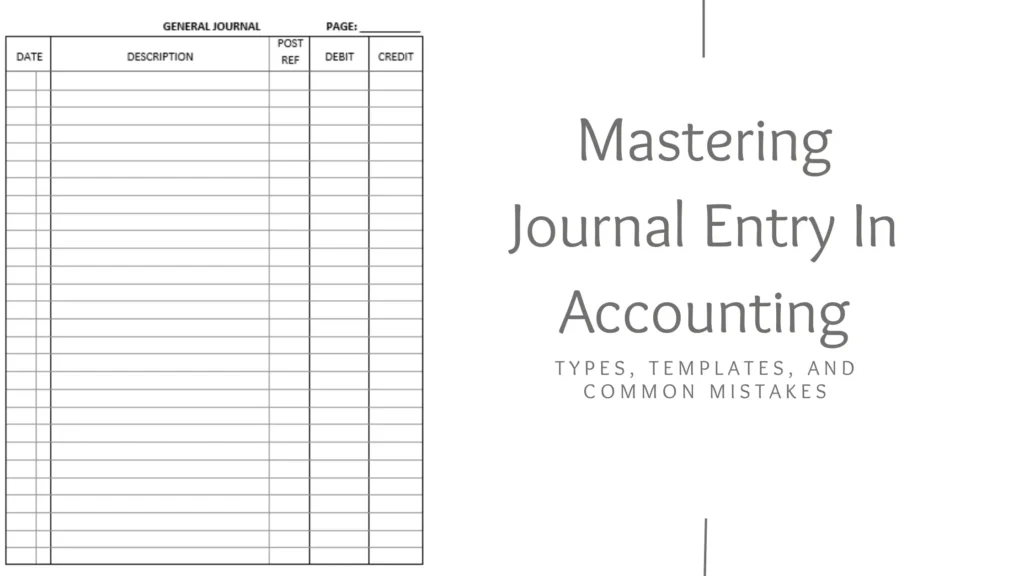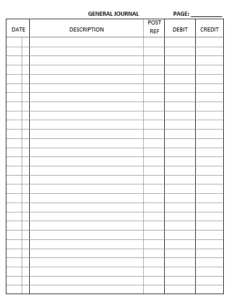If you’re looking to master journal entry accounting, you’ve come to the right place. Whether you’re a beginner in accounting or an experienced professional, understanding journal entry accounting is a foundational step. Journal entries are critical for recording financial transactions and keeping your business books accurate. In this blog post, we’ll walk through what a journal entry is in accounting, the four parts of a journal entry, the types of journal entries, and we’ll provide examples and templates to make things easier for you.
By the end of this guide, you’ll feel confident about making journal entries for a variety of transactions, from depreciation to sales to prepaid expenses.
Don’t forget to check out the tip at the end of this post— Stay tuned for an extra boost to your accounting skills.
What is a Journal Entry in Accounting?
A journal entry is the method used to record financial transactions in an accounting system. Journal entries consist of debits and credits that ensure your accounts are balanced in accordance with the double-entry accounting system. Every transaction affects at least two accounts—one gets debited and the other credited.
Example:
Your company buys a computer for $2,000 in cash. This would increase your assets (computer) and decrease your cash account.
Date | Account Name |
| Debit | Credit |
01/10/2024 | Computer Equipment | $2,000 | ||
Cash | $2,000 | |||
(Purchased computer for business use) |
List the Four Parts of a Journal Entry
Each journal entry consists of four key components:
- Date: When the transaction took place.
- Accounts: The names of the accounts involved.
- Amounts: The monetary values for both the debit and credit.
- Description: A brief explanation of the transaction.
By maintaining this format, you ensure your accounting records are clear and consistent.
Example:
Let’s say you pay $700 for office rent.
Date: 01/12/2024
Account & Amount: Rent Expense (Debit) — $700
Account& Amount: Cash (Credit) — $700
Description: Monthly office rent payment
Date | Account Name |
| Debit | Credit |
01/12/2024 | Rent Expense |
| $700 | |
Cash |
| $700 | ||
| (Monthly office rent payment) |
|
|
|
Journal Entry Template for Quick Use
Here’s a simple journal entry Template you can use for your own records:
Date | Account Name |
| Debit | Credit |
[Date] | [Account to Debit] |
| [$$$] | |
[Date] | [Account to Credit] |
| [$$$] |
This Template helps ensure you capture all the necessary details for accurate bookkeeping.
Common Journal Entries
Date | Account Title | P/R | Debit | Credit |
[Date] | Sales |
| ||
Accounts Receivable |
| [Amount] | ||
Sales Revenue |
| [Amount] | ||
Cost of Goods Sold |
| [Amount] | ||
Inventory |
| [Amount] | ||
———— | ————————————– |
| ———– | ———– |
[Date] | Purchases of Merchandise on Credit |
| ||
Inventory |
| [Amount] | ||
Accounts Payable |
| [Amount] | ||
———— | ————————————– |
| ———– | ———– |
[Date] | Payment of Accounts Payable |
| ||
Accounts Payable |
| [Amount] | ||
Cash |
| [Amount] | ||
———— | ————————————– |
| ———– | ———– |
[Date] | Depreciation Expense |
| ||
Depreciation Expense |
| [Amount] | ||
Allowance for Depreciation |
| [Amount] | ||
———— | ————————————– |
| ———– | ———– |
[Date] | Bad Debt Expense |
| ||
Bad Debt Expense |
| [Amount] | ||
Allowance for doubtful accounts |
| [Amount] | ||
———— | ————————————– |
| ———– | ———– |
[Date] | Prepaid Rent Expense |
| ||
Prepaid Rent Expense |
| [Amount] | ||
Cash |
| [Amount] | ||
———— | ————————————– |
| ———– | ———– |
Types of Journal Entries in Accounting
There are different types of journal entries based on the nature of the transaction. Let’s explore some of the most common entries:
Journal Entry for Sales
Sales are a key part of any business, and it’s important to record these transactions properly to reflect your revenue accurately.
Example:
You sell products worth $4,000 on credit.
Date | Account Name |
| Debit | Credit |
03/15/2024 | Accounts Receivable |
| $4,000 | |
Sales Revenue |
| $4,000 | ||
| (Recorded sale of goods on credit) |
|
|
|
Journal Entry for Accounts Payable
When you make a purchase on credit, you’ll need to record it as accounts payable, which represents the money you owe to suppliers.
Example:
Your company purchases $900 worth of office supplies on credit.
Date | Account Name |
| Debit | Credit |
04/05/2024 | Office Supplies |
| $900 | |
Accounts Payable |
| $900 | ||
| (Purchased office supplies on credit) |
|
|
|
Journal Entry for Bad Debt Expense
When you determine that a customer’s debt is uncollectible, you record it as a bad debt expense. This keeps your accounts receivable accurate.
Example:
Your business determines that a customer owes $5,000 but won’t be able to pay. You decide to write off the debt.
Step 1: Recording the Bad Debt Expense (Allowance Method)
Under the allowance method, bad debts are estimated and recorded as an expense in advance. Here’s the journal entry when you recognize bad debt expense:
Date | Account Name |
| Debit | Credit |
12/31/2024 | Bad Debt Expense | $5,000 | ||
Allowance for Doubtful Accounts | $5,000 | |||
(Record Annual Bad Debt Expense) |
Explanation: This entry recognizes the expected bad debt as an expense and increases the allowance for doubtful accounts, which is a contra-asset account.
Step 2: Writing Off the Bad Debt
When the specific debt is confirmed to be uncollectible, you write it off:
Date | Account Name |
| Debit | Credit |
12/31/2024 | Allowance for Doubtful Accounts | $5,000 | ||
Accounts Receivable | $5,000 | |||
(Annual depreciation for machinery) |
Explanation: This entry removes the receivable from the books without affecting expenses because the bad debt was already accounted for under the allowance method.
Direct Write-Off Method (if used instead of the allowance method)
In some cases, businesses use the direct write-off method, which records the bad debt expense only when a specific account is deemed uncollectible. Here’s the journal entry for this method:
Date | Account Name |
| Debit | Credit |
02/28/2024 | Bad Debt Expense | $5,000 | ||
Accounts Receivable | $5,000 | |||
(Recognized bad debt for uncollectible invoice) |
Explanation: This entry directly records the bad debt as an expense and removes the amount from accounts receivable.
Journal Entry for Depreciation
Depreciation is the process of dividing the cost of a fixed asset over its useful life. This helps businesses match expenses with revenues over time.
Example:
If you have machinery worth $10,000, and its annual depreciation is $1,000, the journal entry looks like this:
Date | Account Name |
| Debit | Credit |
12/31/2024 | Depreciation Expense |
| $1,000 | |
Allowance for Depreciation |
| $1,000 | ||
| (Annual depreciation for machinery) |
|
|
|
Another example of the sale of an asset, how to deal with its accumulated depreciation?
Sanders Corporation sold equipment that originally cost $250,000, and had accumulated depreciation of $180,000, for a cash amount of $90,000.
Date | Account Name |
| Debit | Credit |
12/31/2024 | Cash |
| $90,000 | |
| Accumulated Depreciation |
| 180,000 |
|
| Equipment |
|
| $250,000 |
Gain on Sale of Equipment |
| 20,000 | ||
| (sale of an asset) |
|
|
|
Journal Entry for Deferred Revenue
Deferred revenue is also known as unearned revenue or advance payments. Deferred revenue occurs when you receive payment for a service or product you haven’t yet delivered.
Example:
Your company receives $6,000 on January 1, 2024, for a 12-month service contract to be provided throughout the year. Since the service hasn’t been provided yet, the payment is considered deferred revenue (a liability) until the service is delivered.
Step 1: Initial Recognition of Deferred Revenue
When you receive the payment, you need to record it as a liability (deferred revenue) since the service has not yet been performed.
(This process is part of adjusting entries, see the full guide on 𝐀𝐜𝐜𝐫𝐮𝐚𝐥 𝐀𝐜𝐜𝐨𝐮𝐧𝐭𝐢𝐧𝐠- 𝐄𝐱𝐩𝐥𝐚𝐢𝐧𝐞𝐝 𝐓𝐲𝐩𝐞𝐬 𝐨𝐟 𝐀𝐜𝐜𝐫𝐮𝐚𝐥𝐬)
Date | Account Name |
| Debit | Credit |
01/01/2024 | Cash |
| $6,000 | |
Deferred Revenue |
| $6,000 | ||
| (Recorded unearned revenue) |
|
|
|
Explanation: The company has received cash but hasn’t yet earned the revenue, so it’s recorded as a liability.
Step 2: Recognizing Revenue Monthly
At the end of each month, as the service is provided, you recognize a portion of the deferred revenue as earned revenue. Since the contract is for 12 months, you’ll recognize $500 of revenue each month ($6,000 ÷ 12 months).
Date | Account Name |
| Debit | Credit |
01/31/2024 | Deferred Revenue |
| $500 | |
Service Revenue |
| $500 | ||
| (Recorded unearned revenue) |
|
|
|
Explanation: As the service is provided, deferred revenue decreases, and service revenue increases, reflecting the earnings.
This process will continue every month until the full amount of deferred revenue is recognized as earned revenue by the end of the contract.
Journal Entry for Prepaid Expenses
When you pay for something in advance, like insurance or rent, it’s classified as a prepaid expense until the service is received.
Example:
You pay $12,000 for one year of rent in advance on January 1, 2024. This is a prepaid expense because the rent benefits you over the course of the year, not all at once.
Step 1: Recording Prepaid Rent (Asset)
When you make the payment in advance, you record the prepaid rent as an asset since you haven’t yet received the benefit.
Date | Account Name |
| Debit | Credit |
01/01/2024 | Prepaid Rent |
| $12,000 | |
Cash |
| $12,000 | ||
| (Payment of rent expense in advance) |
|
|
|
Explanation: Prepaid rent is debited because it’s an asset that represents a future benefit. Cash is credited because you’ve paid the rent.
Step 2: Recognizing Rent Expense Monthly
At the end of each month, you recognize a portion of the prepaid rent as an expense. Since the total rent for the year is $12,000, the monthly rent expense would be $1,000 ($12,000 ÷ 12 months).
Date | Account Name |
| Debit | Credit |
| 01/31/2024 | Rent Expense |
| $1,000 | |
Prepaid Rent |
| $1,000 | ||
| (Payment of rent expense in advance) |
|
|
|
Explanation: Each month, part of the prepaid rent is transferred from the asset account to the rent expense account as it is used.
This process repeats each month until the prepaid amount is fully expensed over the 12 months.
General Journal: Accounting Logbook
Stay organized with the General Journal: Accounting Logbook—the easiest way to track daily transactions for your business! Streamline your bookkeeping and make accounting stress-free. Plus, it’s perfect for students learning accounting—it provides pre-formatted journal sheets to help solve practice problems and improve journal entry skills. Grab yours now and simplify your workflow!
FAQs about Journal Entry Accounting
A: Don’t worry! You can always make a correcting journal entry. This could mean reversing the wrong entry or adjusting the specific accounts that were impacted.
A: Most modern accounting software, like Xero or QuickBooks, allows you to automate recurring entries like depreciation or monthly expenses, saving time and reducing errors.
A: Double-entry ensures that for every debit, there’s a corresponding credit, which keeps the books balanced and makes it easier to detect any mistakes.
A: In double-entry accounting, the total debits must equal the total credits in every journal entry. If they don’t, there is an error that must be corrected.
A: Adjusting entries are made at the end of an accounting period to update account balances before preparing financial statements. Examples include depreciation, accruals, and deferrals.
Conclusion
Understanding and mastering journal entry accounting is crucial to maintaining clean financial records for your business. Whether you’re dealing with depreciation, bad debt, or sales, following the examples and templates provided will give you the confidence to record transactions properly.
Ready to sharpen your accounting skills further? Bookmark this guide and refer back to it whenever you need help making your next journal entry!



